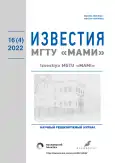Analysis of the efficiency of balancing pistons of feed pumps
- Authors: Zharkovsky A.A.1, Zakharov A.A.1, Fedorov S.P.1,2
-
Affiliations:
- Peter the Great Saint Petersburg Polytechnic University
- Power Machines
- Issue: Vol 16, No 4 (2022)
- Pages: 303-310
- Section: Hydraulic and pneumatic systems
- URL: https://journals.rcsi.science/2074-0530/article/view/126638
- DOI: https://doi.org/10.17816/2074-0530-111040
- ID: 126638
Cite item
Full Text
Abstract
BACKGROUND: Thermo power industry demands the high level of reliability of pump equipment. Regarding that, improvement of reliability of feed pump structure and balancing device in particular is a relevant issue.
AIMS: To perform numerical simulation of a balancing device in order to determine its optimal design and parameters. The study object is the balancing device of the PEN 290-115 feed pump
METHODS: Two types of the balancing piston, two-stage and single-stage, were studied. The series of computational fluid dynamics simulations of the three-dimensional flow of a viscous liquid were performed using the ANSYS CFX software in order to study the efficiency of given designs.
RESULTS: The calculated characteristics of the two designs of the unloading device were obtained. The influence of roughness and radial clearance on the efficiency of a cylindrical piston was studied. The simulation results showed that the radial clearance decrease leads to balancing device losses decrease. The roughness value increase may also lead to the leaks decrease, but its excessive increase leads to friction losses increase, so it is necessary to control both parameters when searching for the optimal roughness value.
CONCLUSIONS: The optimal design of the balancing piston, which combines simplicity of manufacturing, reliability and energy efficiency, is proposed.
Full Text
##article.viewOnOriginalSite##About the authors
Alexander A. Zharkovsky
Peter the Great Saint Petersburg Polytechnic University
Email: azharkovsky@gmail.com
ORCID iD: 0000-0002-3044-8768
SPIN-code: 3637-7853
Scopus Author ID: 7004534701
ResearcherId: T-3278-2018
Dr. Sci. (Tech.), Professor of the Higher School of Power Engineering of the Institute of Energy
Russian Federation, 29 Polytechnicheskaya street, 195251 Saint PetersburgAlexander A. Zakharov
Peter the Great Saint Petersburg Polytechnic University
Author for correspondence.
Email: zakharov.aa.gm@yandex.ru
ORCID iD: 0000-0001-9657-1921
SPIN-code: 5447-4090
Engineer of the Hydromechanical Engineering Laboratory of the Higher School of Power Engineering, Institute of Energy
Russian Federation, 29 Polytechnicheskaya street, 195251 Saint PetersburgSergei P. Fedorov
Peter the Great Saint Petersburg Polytechnic University; Power Machines
Email: fedorov_sp@power-m.ru
ORCID iD: 0000-0003-1426-7526
SPIN-code: 5071-5400
Postgraduate student, Head of the Design of Small Hydraulic Machines Department
Russian Federation, 29 Polytechnicheskaya street, 195251 Saint Petersburg; Saint PetersburgReferences
- Shpil Yu. Trends in the development of feed pumps. Vestnik YuUrGU. 2005;1:32–46.
- Gulich JF. Centrifugal Pumps. Berlin, Heidelberg: Springer; 2010. doi: 10.1007/978-3-642-12824-0
- Lomakin AA. Centrifugal and axial pumps. Leningrad: Mashinostroenie; 1966.
- Bushziper P. Design concept of Sulzer feed pumps. Vestnik YuUrGU. 2005;1:65–72.
- Makay E., Szamody O. Survey of feedpump outages. Final report. Morrisville: Energy Re-search and Consultants Corporation; 1978. Report No.: 641. Contract No.: EPRI FP-754. Режим доступа: https://www.osti.gov/servlets/purl/7039347 дата обращения: 11.07.2022.
- Akimov S.V. Razrabotka metodov matematicheskogo modelirovaniya i povysheniya ener-goeffektivnosti neftyanykh magistralnykh nasosov putem modernizatsii poverkhnosti elementov protochnoy chasti [dissertation] St. Petersburg; 2022. doi: 10.18720/SPBPU/2/r22-3
Supplementary files














